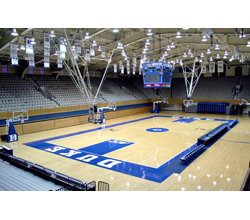
When it opened in 1940 with a capacity of 7,000, Cameron Indoor Stadium was the largest indoor arena in the southern United States.
Today, relatively unchanged after more than 65 years, it’s one of the smaller collegiate arenas in the nation, but a funny thing happened along the way: Cameron Indoor Stadium has deservedly earned legendary status as one of the truly great places to attend college basketball games.
In fact, Sports Illustrated magazine ranks it number four on a list of the world’s most prestigious sporting venues.
Located on the campus of Duke University in Durham, North Carolina, Cameron Indoor Stadium benefits both the Blue Devils men’s and women’s NCAA basketball teams with intimate seating arrangements that include bleacher-style seats alongside the court reserved for students. Nicknamed the Cameron Crazies, they’ve made a name for themselves as Duke’s exceptional “sixth man,” practicing the art of supporting their team creatively.
Some minor renovations have occurred over the decades, most notably in 1988, when a new electronic scoreboard, new sound system and decorative wood paneling gave Cameron an updated look, with seating capacity increased to 9,314. Yet the university’s mission remains to steadfastly maintain the venue’s original charm and elegance.
Against this backdrop, SPL Integrated Solutions (now AVI-SPL) of Columbia, Maryland, was invited in mid-2007 to submit ideas for a new arena-wide sound reinforcement system to the university’s facilities management and athletic departments as part of another subtle renovation phase. (View our Photo Gallery of this project.) Justo Gutierrez of AVI-SPL took the lead in evolving discussions regarding the new system, and as a Duke alumnus (and past Cameron Crazy), he brought valuable context and insight to the specific requirements of the project.
“With Cameron Indoor Stadium being one of the most recognized sporting venues in the world, we always want to continue to upgrade the facility while keeping the charm and setting that makes it one of the truly special arenas in America,” notes Michael Sobb, Assistant Athletic Director, Marketing, Duke University Athletics. “AVI-SPL took the time to really listen to us, and stood out from all the companies that we spoke to in really understanding what we were trying to do in Cameron.”
The previous system offered the classic central cluster approach – compression drivers on horns combined with low-frequency enclosures – that was standard practice in the 1980s. It served the venue well for two decades, but had since been eclipsed in terms of functionality, coverage and aesthetics by newer audio technologies.
Following a site survey, AVI-SPL offered some preliminary recommendations. All parties strongly favored a distributed approach, due in part to a relatively low ceiling height and a strong desire not to impact the arena’s classic look, in addition to the dramatic performance gains that can be realized with proper deployment.
